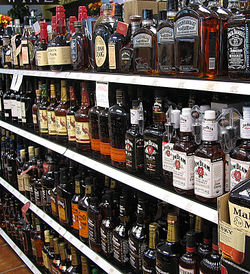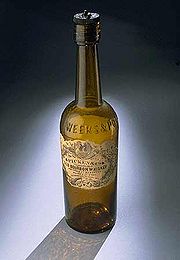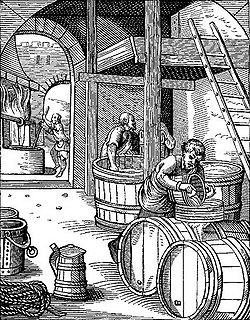Bourbon whiskey

Bourbon is an American whiskey, a type of distilled spirit, made primarily from corn (maize) and named for Bourbon County, Kentucky. It has been produced since the 18th century. While it may be made anywhere in the United States, it is strongly associated with the Commonwealth of Kentucky.
Contents |
Legal requirements
On May 4, 1964, the United States Congress recognized Bourbon Whiskey as a "distinctive product of the United States." The Federal Standards of Identity for Distilled Spirits (27 C.F.R. 5.22) state that bourbon must meet these requirements:
- Bourbon must be made of a grain mixture that is at least 51% corn.[1]
- Bourbon must be distilled to no more than 160 (U.S.) proof (80% alcohol by volume).
- Neither coloring nor flavoring may be added.
- Bourbon must be aged in new, charred oak barrels. [1]
- Bourbon must be entered into the barrel at no more than 125 proof (62.5% alcohol by volume).
- Bourbon, like other whiskeys, may not be bottled at less than 80 proof (40% alcohol by volume.)
- Bourbon which meets the above requirements and has been aged for a minimum of two years, may (but is not required to) be called Straight Bourbon.[2]
- Straight Bourbon aged for a period less than four years must be labeled with the duration of its aging.
- If an age is stated on the label, it must be the age of the youngest whiskey in the bottle.
- Only whiskey produced in the United States can be called bourbon.[3]

In practice, almost all bourbons marketed today are made from more than two-thirds corn, have been aged at least four years, and do qualify as "straight bourbon"—with or without the "straight bourbon" label. The exceptions are inexpensive commodity brands of bourbon aged only three years and pre-mixed cocktails made with straight bourbon aged the minimum two years. However, a few small distilleries market bourbons aged for as little as three months.
Production process
The typical grain mixture for bourbon, known as the mash bill, is 70% corn with the remainder being wheat and/or rye, and malted barley. The grain is ground, dissolved in water, and usually, though not always, mash from a previous distillation is added to ensure a consistent pH across batches. Finally, yeast is added and the mash is fermented. The fermented mash is then distilled to (typically) between 65% and 80% alcohol.
This clear spirit is placed in charred oak barrels for aging, during which it gains color and flavor from the wood. Changes to the spirit also occur due to evaporation and chemical processes such as oxidation. Bourbons gain more color and flavor the longer they age. Maturity, not a particular age, is the goal. Bourbon can age too long and become woody and unbalanced.
After aging, bourbon is withdrawn from the barrel, usually diluted with water and bottled to at least 80 US proof (40% abv).[4] Most bourbon whiskey is sold at 80 US proof. Other common proofs are 86, 90, 94, 100 and 107, and whiskeys of up to 151 proof have been sold. Some higher proof bottlings are "barrel proof," meaning that they have not been diluted after removal from the barrels.
Bourbon whiskey may be sold at less than 80 proof but must be labeled as "diluted bourbon."
Geographic origin
Bourbon may be produced anywhere in the United States where it is legal to distill spirits. Currently most brands are produced in Kentucky, where bourbon has a strong association. Estimates are that 95% of the world's bourbon is distilled and aged in Kentucky.[5] Bourbon has also been made in Colorado, Kansas, Illinois, Indiana, Missouri, New Jersey, New York, Ohio, Pennsylvania, Tennessee, Texas, and Virginia.[6][7]
Bardstown, Kentucky, is called the Bourbon Capital of the World and is home to the annual Bourbon Festival in September.
The Kentucky Bourbon Trail is the name of a tourism promotion intended to attract visitors to six well-known distilleries: Four Roses (Lawrenceburg), Heaven Hill (Bardstown), Jim Beam (Clermont), Maker's Mark (Loretto), Wild Turkey (Lawrenceburg), and Woodford Reserve (Versailles).[8]
History

The origin of bourbon is not well documented. Instead, there are many conflicting legends and claims, some more credible than others. For example, the invention of bourbon is often attributed to a pioneering Baptist minister and distiller named Elijah Craig. Rev. Craig (credited with many Kentucky firsts, e.g., fulling mill, paper mill, ropewalk, etc.) is said to also be the first to age the distillation in charred oak casks, "a process that gives the bourbon its reddish color and unique taste."[9] Across the county line in Bourbon County, an early distiller named Jacob Spears is credited with being the first to label his product "Bourbon whiskey." Spears' home, Stone Castle, warehouse and spring house survive; one can drive by the Spears home on Clay-Kaiser Road.
Although still popular and often repeated, the Craig legend has little actual credibility. Similarly, the Spears story is a local favorite, rarely repeated outside the county. There likely was no single "inventor" of bourbon, which developed into its present form only in the late 19th century.[10]
Distilling probably arrived in what would later become known as Kentucky when Scottish, Scots-Irish, and other settlers (including, English, Irish, German, and French) began to farm the area in earnest in the late 18th century. The spirit they made evolved and gained a name in the early 19th century.
| “ | When American pioneers pushed west of the Allegheny Mountains following the American Revolution, the first counties they founded covered vast regions. One of these original, huge counties was Bourbon, established in 1785 and named after the French royal family. While this vast county was being carved into many smaller ones, early in the 19th century, many people continued to call the region Old Bourbon. Located within Old Bourbon was the principal Ohio River port from which whiskey and other products were shipped. "Old Bourbon" was stencilled on the barrels to indicate their port of origin. Old Bourbon whiskey was different because it was the first corn whiskey most people had ever tasted. In time, bourbon became the name for any corn-based whiskey.[11] | ” |
A refinement variously credited to either James C. Crow or Jason S. Amburgey[12] was the sour mash process, by which each new fermentation is conditioned with some amount of spent mash (previously fermented mash that has been separated from its alcohol). Spent mash is also known as spent beer, distillers' spent grain, stillage, and slop or feed mash, so named because it is used as animal feed. The acid introduced by using the sour mash controls the growth of bacteria that could taint the whiskey and creates a proper pH balance for the yeast to work.
As of 2005[update], all straight bourbons use a sour mash process. Crow or Amburgey developed this refinement while working at the Old Oscar Pepper Distillery (now the Woodford Reserve Distillery) in Woodford County, Kentucky. As of today, there are no running distilleries within the current boundaries of Bourbon County due to new counties being formed from Bourbon County over time.
A resolution of the U.S. Congress in 1964 declared bourbon to be a "distinctive product of the United States."[13][14] That resolution asked "the appropriate agencies of the United States Government... [to] take appropriate action to prohibit importation into the United States of whiskey designated as 'Bourbon Whiskey.'"[13] Federal regulation now defines "bourbon whisky" to only include "bourbon" produced in the United States.[15]
National Bourbon Heritage Month
On August 2, 2007, the U.S. Senate passed a resolution sponsored by Senator Jim Bunning (R-KY) officially declaring September 2007 "National Bourbon Heritage Month", marking the history of bourbon whiskey.[16] Notably, the resolution claims that Congress declared bourbon to be "America's Native Spirit" in its 1964 resolution.[16] The 1964 resolution, however, does not contain such a statement per se; it only declares that bourbon is a distinctive product identifiable with the United States in the same way that Scotch is identifiable with Scotland.[13] The resolution has been passed each year since.
Present day
Since 2003, high-end bourbons have seen revenue grow from $450 million to over $500 million (£231 million to over £257 million or €308 million to over €343 million), some 2.2 million cases, in the United States. High-end bourbon sales accounted for eight percent of total spirits growth in 2006. Most high-end bourbons are aged for six years or longer.[17]
In 2007, United States spirits exports, virtually all of which are American whiskey, exceeded $1 billion for the first time. This represents a 15 percent increase over 2006. American whiskey is now sold in more than 100 countries. The leading markets are the United Kingdom, Canada, Germany, Australia, and Japan. Key emerging markets for American whiskey are China, Vietnam, Brazil, Chile, Romania, and Bulgaria.[18]
See also
- List of bourbon brands
- List of cocktails with bourbon
- List of whisky brands
- Corn whiskey
- Rye whiskey
- Moonshine
- Tennessee whiskey
- American whiskey
- American Whiskey Trail
- Bourbon Trail
- Bottled in bond
- Single barrel bourbon
- Small batch
References
- ↑ 1.0 1.1 "27 C.F.R. sec 5.22(b)(1)(i)". Ecfr.gpoaccess.gov. http://ecfr.gpoaccess.gov/cgi/t/text/text-idx?c=ecfr&sid=21224b7c634d83e0fa329bfd18bb85dc&rgn=div8&view=text&node=27:1.0.1.1.3.3.25.2&idno=27. Retrieved 2010-08-05.
- ↑ "27 C.F.R. sec 5.22(b)(1)(iii)". Ecfr.gpoaccess.gov. http://ecfr.gpoaccess.gov/cgi/t/text/text-idx?c=ecfr&sid=21224b7c634d83e0fa329bfd18bb85dc&rgn=div8&view=text&node=27:1.0.1.1.3.3.25.2&idno=27. Retrieved 2010-08-05.
- ↑ "27 C.F.R. sec 5.22(l)(1)". Ecfr.gpoaccess.gov. http://ecfr.gpoaccess.gov/cgi/t/text/text-idx?c=ecfr&sid=21224b7c634d83e0fa329bfd18bb85dc&rgn=div8&view=text&node=27:1.0.1.1.3.3.25.2&idno=27. Retrieved 2010-08-05.
- ↑ "27 C.F.R. sec 5.22(b)". Ecfr.gpoaccess.gov. http://ecfr.gpoaccess.gov/cgi/t/text/text-idx?c=ecfr&sid=21224b7c634d83e0fa329bfd18bb85dc&rgn=div8&view=text&node=27:1.0.1.1.3.3.25.2&idno=27. Retrieved 2010-08-05.
- ↑ "Kentucky Bourbon Trail". Official Web Site. Kentucky Department of Travel, Kentucky Tourism. 2008-09-28. http://www.kybourbontrail.com/#tour. Retrieved 2008-09-28.
- ↑ "Whisky Regions". http://www.whiskyportal.com/region_overview.asp. Retrieved 2008-04-21.
- ↑ "Handmade Texas bourbon hits HillCo". http://www.kxan.com/dpp/news/local/handmade-texas-bourbon-hits-hillco. Retrieved 2010-07-29.
- ↑ kybourbontrail.org
- ↑ John E. Kleber, ed., The Kentucky Encyclopedia (Lexington: University Press of Kentucky, 1992), 103
- ↑ Cowdery, Charles K., "Who Invented Bourbon?" Malt Advocate Magazine (4th Quarter 2002), pp. 72-75
- ↑ Cowdery, Charles K., Bourbon, Straight: The Uncut and Unfiltered Story of American Whiskey, p. 25
- ↑ "What is Sour Mash?". Wisegeek.com. http://www.wisegeek.com/what-is-sour-mash.htm. Retrieved 2010-08-05.
- ↑ 13.0 13.1 13.2 78 Stat. 1208 (1964).
- ↑ Defining "Bourbon." The State (Columbia, SC), 5-1-02, p. D1.
- ↑ "27 C.F.R. sec 5.22(b)(2)". Ecfr.gpoaccess.gov. http://ecfr.gpoaccess.gov/cgi/t/text/text-idx?c=ecfr&sid=21224b7c634d83e0fa329bfd18bb85dc&rgn=div8&view=text&node=27:1.0.1.1.3.3.25.2&idno=27. Retrieved 2010-08-05.
- ↑ 16.0 16.1 S. Res. No. 110-294 (2007).
- ↑ "Celebrate "National Bourbon Heritage Month" With the Classic Bourbon Cocktails". Distilled Spirits Council of the United States. 2007-08-31. http://www.discus.org/media/press/article.asp?NEWS_ID=450. Retrieved 2008-01-12.
- ↑ Distilled Spirits Council of the United States, January, 2008.
Further reading
- Cowdery, Charles K. Bourbon, Straight: The Uncut and Unfiltered Story of American Whiskey (Chicago: Made and Bottled in Kentucky), 2004. ISBN 0-9758703-0-0
- Crowgey, Henry G. Kentucky Bourbon: The Early Years of Whiskeymaking (Lexington, KY: The University Press of Kentucky), 1971. ISBN 0-8131-1225-7
- Regan, Gary and Mardee Haidin Regan. The Bourbon Companion: A Connoisseur's Guide (Philadelphia, PA: Running Press), 1998. ISBN 0-7624-0013-7
External links
- Building a better barrel - AP - 09-June-2007
|
|||||||||||||||||||||||||||||||||||||||||||||||||||||||||||||


